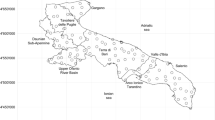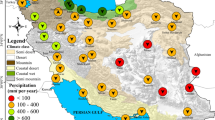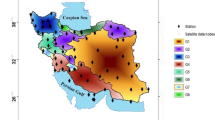Abstract
Drought is one of the most complex phenomena in the world; so, proper management is very important in monitoring and reducing its damage. For this purpose, Standard Precipitation Index (SPI), Standardized Precipitation Evapotranspiration Index (SPEI), and Reconnaissance Drought Index (RDI) indices were used to analyze the intensity and frequency of drought in the coastal wet, mountain, semi-mountain, semi-desert, desert, and coastal desert climates of Iran in four seasons, separately: autumn, winter, spring, and summer. Forty-three synoptic stations with a common statistical period of 50 years (1969–2019) were selected. The results showed that the trend of drought in winter and summer is increasing in all studied climates. The comparison of the results in the trend analysis of the drought showed the same trend, but the SPEI index compared to the other indicators showed a quicker response to changes in drier climates. The highest correlation (0.80–0.99) between SPI-RDI and SPEI-RDI indices in coastal desert, mountain, and semi-mountain climates and the lowest correlation (0.34) between SPI-SPEI and SPEI-RDI indices in semi-desert, desert, and coastal desert climates were obtained. SPI-RDI variations showed similar values in colder climates. The SPEI is based on precipitation and temperature data, and it has the advantage of combining multi-scalar character with the capacity to include the effects of temperature variability in the drought assessment. Thus, SPEI is recommended as a suitable index for studying and identifying the effect of climate change on drought conditions.






Similar content being viewed by others
Data availability
All data used in this paper for Iran were extracted from metrological stations’ data and can also be requested from the corresponding author.
Code availability
Not applicable.
Abbreviations
- CP:
-
changing point
- \(\widehat{\sigma }\) :
-
Standard deviation of the values of Yk
- \(\overline{Y }\) :
-
Arithmetic mean of the values of Yk
- \({\overline{a} }_{k}\) :
-
Values follow the normal log distribution Yk is equal to \({lna}_{k}\)
- \(\alpha\), \(\beta\) and \(\gamma\) :
-
Yk The scale, shape and principal parameters for the values of Di
- Aut.:
-
Autumn
- Di :
-
Water balance
- DOY:
-
Day format of the year
- ea :
-
Actual vapor pressure
- ED:
-
Extremely Drought
- es :
-
Saturation vapor pressure (kPa)
- ETref :
-
Reference evapotranspiration
- EW:
-
Extremely wet
- FAO:
-
Food and Agriculture Organization
- G:
-
Soil heat flux density (MJ m−2 d−1)
- MD:
-
Moderately Drought
- MW:
-
Moderately Wet
- PM-FAO56 :
-
Penman–Monteith equation based on FAO 56
- RDI:
-
Reconnaissance Drought Index
- RDIn:
-
Normalized RDI values
- RDIst:
-
Standardized RDI
- Rn :
-
Net radiation (MJ m−2 d−1)
- SD:
-
Severe Drought
- SPEI:
-
Standardized Precipitation Evapotranspiration Index
- SPI:
-
Standard Precipitation Index
- Spr.:
-
Spring
- Sum.:
-
Summer
- Ta :
-
Average air temperature (°C)
- Tmax :
-
Maximum temperature
- Tmean :
-
Average temperature
- Tmin :
-
Minimum temperature
- u2 :
-
Average wind speed at 2 m height (m s−1)
- VW:
-
Severely wet
- Win.:
-
Winter
- γ:
-
Psychometric constant (kPa °C)
- Δ:
-
The slope of the saturation vapor pressure function (kPa °C)
- μ1 :
-
Mutation 1
- μ2 :
-
Mutation 2
References
Abramowitz M, Stegun IA (1965) Handbook of mathematical functions Dover Publications. New York, 361
Alijani B, Ghohroudi M, Arabi N (2008) Developing a climate model for Iran using GIS. Theoret Appl Climatol 92(1):103–112
Bachmair S, Stahl K, Collins K, Hannaford J, Acreman M, Svoboda M, ... Overton IC (2016) Drought indicators revisited: the need for a wider consideration of environment and society. Wiley Interdisciplinary Reviews: Water, 3(4), 516-536
Barker L, Hannaford J, Chiverton A, Svensson C (2016) From meteorological to hydrological drought using standardised indicators. Hydrology Earth System Sciences 20:2483–2505
Beguería S, Vicente-Serrano SM, Reig F, Latorre B (2014) Standardized precipitation evapotranspiration index (SPEI) revisited: parameter fitting, evapotranspiration models, tools, datasets and drought monitoring. Int J Climatol 34(10):3001–3023
Byakatonda J, Parida BP, Moalafhi DB, Kenabatho PK (2018) Analysis of long term drought severity characteristics and trends across semiarid Botswana using two drought indices. Atmos Res 213:492–508
Cloppet, E. (2011). Agricultural drought indices in France and Europe: strengths, weaknesses, and limitations. In Agricultural Drought Indices—Proceedings of an Expert Meeting (pp. 2–4)
Dai A (2011) Drought under global warming: a review. Wiley Interdisciplinary Reviews: Climate Change 2(1):45–65
Danandeh Mehr A, Sorman AU, Kahya E, Hesami Afshar M (2020) Climate change impacts on meteorological drought using SPI and SPEI: case study of Ankara. Turk Hydrol Sci J 65(2):254–268
Edwards DC (1997) Characteristics of 20th century drought in the United States at multiple time scales. AIR FORCE INST OF TECH WRIGHT-PATTERSON AFB OH.
Farahmand A, AghaKouchak A (2015) A generalized framework for deriving nonparametric standardized drought indicators. Adv Water Resour 76:140–145
Ficklin DL, Maxwell JT, Letsinger SL, Gholizadeh H (2015) A climatic deconstruction of recent drought trends in the United States. Environ Res Lett, 10(4), 044009.
Gao ZL, Fu YL, Li YH, Liu JX, Chen N, Zhang XP (2012) Trends of streamflow, sediment load and their dynamic relation for the catchments in the middle reaches of the Yellow River over the past five decades. Hydrol Earth Syst Sci 16(9):3219–3231
Güner Bacanli Ü (2017) Trend analysis of precipitation and drought in the A egean region T Urkey. Meteorol Appl 24(2):239–249
Guo D, Westra S, Holger R (2017) Sensitivity of potential evapotranspiration to changes in climate variables for different Australian climatic zones. Hydrol Earth System Sci 21:2107–2126. https://doi.org/10.5194/hess-21-2107-2017
Haile GG, Tang Q, Sun S, Huang Z, Zhang X, Liu X (2019) Droughts in East Africa: causes, impacts and resilience. Earth Sci Rev 193:146–161
Hatefi A, Mosaedi A, Jabbbari Nooghabi M (2016) The role of evapotranspiration in meteorological drought monitoring in some climatic regions of the country. J Water Soil Conserv 23(2):1–21
Hosseini-Moghari SM, Araghinejad S (2015) Monthly and seasonal drought forecasting using statistical neural networks. Environ Earth Sci 74(1):397–412
Huang J, Ji M, Xie Y, Wang S, He Y, Ran J (2016) Global semi-arid climate change over last 60 years. Clim Dyn 46(3–4):1131–1150
Jamshidi H, Khalili D, Zadeh MR, Hosseinipour EZ (2011) Assessment and comparison of SPI and RDI meteorological drought indices in selected synoptic stations of Iran. In World Environmental and Water Resources Congress 2011: Bearing Knowledge for Sustainability (pp. 1161–1173)
Jehanzaib M, Sattar MN, Lee JH, Kim TW (2020) Investigating effect of climate change on drought propagation from meteorological to hydrological drought using multi-model ensemble projections. Stoch Env Res Risk Assess 34(1):7–21
Kisi O, Sanikhani H, Zounemat-Kermani M, Niazi F (2015) Long-term monthly evapotranspiration modeling by several data-driven methods without climatic data. Comput Electron Agric 115:66–77
Kwon M, Kwon HH, Han D (2019) Spatio-temporal drought patterns of multiple drought indices based on precipitation and soil moisture: a case study in South Korea. Int J Climatol 39(12):4669–4687
Liu L, Liao J, Chen X, Zhou G, Su Y, Xiang Z, ... Shao H (2017) The Microwave Temperature Vegetation Drought Index (MTVDI) based on AMSR-E brightness temperatures for long-term drought assessment across China (2003–2010). Remote Sens Environ 199:302–320
Logan KE, Brunsell NA, Jones AR, Feddema JJ (2010) Assessing spatiotemporal variability of drought in the US central plains. J Arid Environ 74(2):247–255
Lu X, Bai H, Mu X (2016) Explaining the evaporation paradox in Jiangxi Province of China: spatial distribution and temporal trends in potential evapotranspiration of Jiangxi Province from 1961 to 2013. Int Soil Water Conserv Res 4(1):45–51
Madani K (2014) Water management in Iran: what is causing the looming crisis? J Environ Stud Sci 4(4):315–328. https://doi.org/10.1007/s13412-014-0182-z
Mahmoudi P, Rigi A, Kamak MM (2019) A comparative study of precipitation-based drought indices with the aim of selecting the best index for drought monitoring in Iran. Theor Appl Climatol 137(3):3123–3138
Mazdiyasni O, AghaKouchak A (2015) Substantial increase in concurrent droughts and heatwaves in the United States. Proc Natl Acad Sci 112(37):11484–11489
McEvoy DJ, Huntington JL, Abatzoglou JT, Edwards LM (2012) An evaluation of multiscalar drought indices in Nevada and eastern California. Earth Interact 16(18):1–18
McKee TB, Doesken NJ, Kleist J (1993, January) The relationship of drought frequency and duration to time scales. In Proceedings of the 8th Conference on Applied Climatology (Vol. 17, No. 22, pp. 179–183).
Mehr AD, Vaheddoost B (2020) Identification of the trends associated with the SPI and SPEI indices across Ankara Turkey. Theoretic Appl Climatol 139(3):1531–1542
Mohammed R, Scholz M (2017) The reconnaissance drought index: a method for detecting regional arid climatic variability and potential drought risk. J Arid Environ 144:181–191
Mohammed R, Scholz M (2019) Climate variability impact on the spatiotemporal characteristics of drought and Aridityin arid and semi-arid regions. Water Resour Manage 33(15):5015–5033
Panahi DM, Kalantari Z, Ghajarnia N, Seifollahi-Aghmiuni S, Destouni G (2020) Variability and change in the hydro-climate and water resources of Iran over a recent 30-year period. Sci Rep 10(1):1–9
Pathak AA, Dodamani BM (2019) Comparison of meteorological drought indices for different climatic regions of an Indian river basin. Asia-Pacific J Atmos Sci, 1–14
Pettitt AN (1979) A non-parametric approach to the change-point problem. J Roy Stat Soc: Ser C (appl Stat) 28(2):126–135
Potop V, Možný M (2011) The application a new drought index–standardized precipitation evapotranspiration index in the Czech Republic. Mikroklima a Mezoklima Krajinných Structur a Antropogenních Prostředí 2:2–14
Salimi H, Asadi E, Darbandi S (2021) Meteorological and hydrological drought monitoring using several drought indices. Appl Water Sci 11(2):1–10
Sharafi S, Ghaleni MM (2021a) Calibration of empirical equations for estimating reference evapotranspiration in different climates of Iran. Theoret Appl Climatol, 1–15
Sharafi S, Ghaleni MM (2021b) Evaluation of multivariate linear regression for reference evapotranspiration modeling in different climates of Iran. Theoret Appl Climatol 143(3):1409–1423
Sharafi S, Karim NM (2020) Investigating trend changes of annual mean temperature and precipitation in Iran. Arab J Geosci 13(16):1–11
Sharafi S, Ramroudi M, Nasiri M, Galavi M, Kamali GA (2016) Role of early warning systems for sustainable agriculture in Iran. Arab J Geosci 9(19):1–17
Sharma S, Mujumdar P (2017) Increasing frequency and spatial extent of concurrent meteorological droughts and heatwaves in India. Sci Rep 7(1):1–9
Svoboda M, Fuchs B (2016) Handbook of drought indicators and indices
Tabari H, Nikbakht J, Talaee PH (2013) Hydrological drought assessment in Northwestern Iran based on streamflow drought index (SDI). Water Resour Manage 27(1):137–151
Tsakiris G, Vangelis HJEW (2005) Establishing a drought index incorporating evapotranspiration. European Water 9(10):3–11
Tsakiris G, Pangalou D, Vangelis H (2007) Regional drought assessment based on the Reconnaissance Drought Index (RDI). Water Resour Manage 21(5):821–833
Vicente-Serrano SM, Beguería S, López-Moreno JI (2010a) A multiscalar drought index sensitive to global warming: the standardized precipitation evapotranspiration index. J Clim 23(7):1696–1718
Vicente-Serrano SM, Beguería S, López-Moreno JI, Angulo M, El Kenawy A (2010b) A new global 0.5 gridded dataset (1901–2006) of a multiscalar drought index: comparison with current drought index datasets based on the Palmer Drought Severity Index. J Hydrometeorol, 11(4), 1033–1043
Vicente-Serrano SM, Beguería S, Lorenzo-Lacruz J, Camarero JJ, López-Moreno JI, Azorin-Molina C, ... Sanchez-Lorenzo A (2012) Performance of drought indices for ecological, agricultural, and hydrological applications. Earth Interact, 16(10), 1-27
Vicente-Serrano SM, Gouveia C, Camarero JJ, Beguería S, Trigo R, López-Moreno JI, Sanchez-Lorenzo A (2013) Response of vegetation to drought time-scales across global land biomes. Proc Natl Acad Sci 110(1):52–57
Vicente-Serrano SM, López-Moreno JI, Gimeno L, Nieto R, Morán-Tejeda E, Lorenzo-Lacruz J, ... Azorin-Molina C (2011) A multiscalar global evaluation of the impact of ENSO on droughts. J Geophys Res: Atmos, 116(D20)
Vicente-Serrano SM, Van der Schrier G, Beguería S, Azorin-Molina C, Lopez-Moreno JI (2015) Contribution of precipitation and reference evapotranspiration to drought indices under different climates. J Hydrol 526:42–54
Wable PS, Jha MK, Shekhar A (2019) Comparison of drought indices in a semi-arid river basin of India. Water Resour Manage 33(1):75–102
Wang F, Wang Z, Yang H, Di D, Zhao Y, Liang Q (2020) Utilizing GRACE-based groundwater drought index for drought characterization and teleconnection factors analysis in the North China Plain. J Hydrol, 585, 124849
Wang K, Dickinson RE, Liang S (2012) Global atmospheric evaporative demand over land from 1973 to 2008. J Clim 25(23):8353–8361
Yihdego Y, Vaheddoost B, Al-Weshah RA (2019) Drought indices and indicators revisited. Arab J Geosci 12(3):69
Zarch MAA, Malekinezhad H, Mobin MH, Dastorani MT, Kousari MR (2011) Drought monitoring by reconnaissance drought index (RDI) in Iran. Water Resour Manage 25(13):3485–3504
Author information
Authors and Affiliations
Contributions
S.S. and M.M.G. prepared data and performed model runs, designed the study, interpreted the results, and wrote the manuscript.
Corresponding author
Ethics declarations
Ethics approval and consent to participate
Not applicable.
Consent for publication
Not applicable.
Conflict of interest
The authors have no conflicts of interest to declare.
Additional information
Publisher's note
Springer Nature remains neutral with regard to jurisdictional claims in published maps and institutional affiliations.
Rights and permissions
About this article
Cite this article
Sharafi, S., Ghaleni, M.M. Spatial assessment of drought features over different climates and seasons across Iran. Theor Appl Climatol 147, 941–957 (2022). https://doi.org/10.1007/s00704-021-03853-0
Received:
Accepted:
Published:
Issue Date:
DOI: https://doi.org/10.1007/s00704-021-03853-0




